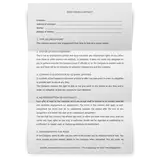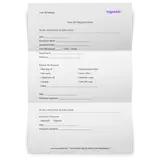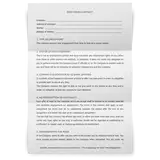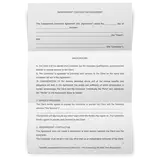Here’s a sample Purchase Order template that can be easily customized and adapted to meet your requirements. You can download and use it for free to improve your supplier management and purchase order process.
You can take this template and upload it to Google Sheets for free online use for your next contract purchase.
The importance of a purchase order
Purchase orders are necessities for any business. They can be used in commercial transactions between a company and vendor(s), or even between a company and a customer. Having a purchase order is important because it is a process control tool that is beneficial to any business.
A purchase order provides a clear communication of various requirements with suppliers. It serves as a protective legal document between the parties involved and is a necessity for audit procedures. Purchase orders are not considered sales invoices even though they are legally binding documents.
These are standard purchase documents that help you keep an official record of unit prices, payment terms, shipping terms, the preferred payment method for the purchasing process and more.
Essentials that make a proper purchase order
In order for a purchase order to be properly created, one must include detailed information about both the company and the vendor involved in the transaction. The details include sections such as the quantity of a product, its prices, the detailed description of the product, taxation, and any other payment indications, shipping details and more that both parties agree on.
If there are any issues regarding the purchase order, then the order can be deliberated between the ordering company and the vendor involved. There are other essentials needed in order to make a proper purchase order. The purchase order forms and the purchase order form template are going to be different, based on your industry and what you're purchasing.
Provide contact information
When creating a purchase order, providing the contact information between both parties is required, so include both the seller details and the vendor details. The contact information should include the name, address, email, phone number, and any other contact information (i.e. fax number, etc.) for both companies.
Because both parties use the purchase order, the contact information is needed for future transactions and communication in general. Unlike item details, the contact remains the same so you can store it in your template purchase order documents and save for later use.
Having a purchase order number (P.O. number)
In order for both the vendor and the ordering company to track the purchase orders, it is important to have a clear P.O. number. This ensures that both sides have the ability to access the information of the purchase order both quickly and efficiently.
The P.O. number would likely be tracked within a centralized computer system. The P.O. Number is usually located in the top right corner of the purchase order. It helps keep an accurate record of the procurement process and for many businesses, it means leaving a paper trail for future reference and tracking.
Item stock keeping unity numbers (SKU Numbers)
Sometimes a purchase order has raw materials included. If this is the case, a purchase order should include individual stock keeping unit numbers (or SKU numbers) for each material.
These numbers usually consist of eight alphanumeric digits for each item, ensuring that the correct products are selected and priced correctly. SKU numbers can help crosscheck a purchase order as well as keep track of the stock levels of products internally.
Keeping relevant details such as SKUs in a purchase order spreadsheet helps make the purchase request more orderly and avoids issues later on.
Description of items
Item names as well as detailed information for each item (i.e. size, color, model number, etc.) are normally listed under the item description field of the purchase order. This makes each item easier to recognize and identify rather than an alphanumeric number alone.
Having accurate product descriptions is just as important as having the right shipping address. In case of confusion later on, you can refer to the relevant details in this section.
Item quantity
The amount of each ordered item is important to include in the purchase order. The quantity of each item should be clearly aligned with their respective product code and its description. This helps in configuring the prices of the items as well as the possibilities of any back orders of items or their availability.
This section is crucial for the inventory management process, so do not leave it out from the official order form.
Prices
The prices for each product should be included in correspondence with the quantities of the items. This ensures that the amounts of each item being charged can clearly be seen. The prices usually include the price for an individual item and then the price for the quantity of said item. Normally, any discounts, sales prices or special terms are listed with the totals of the purchase order.
Subtotals, taxes, discounts and totals of a purchase order
Near the end of the purchase order, the subtotals, discounts, taxes, and totals are usually listed together. More specifically, you can find these totals at the bottom right-hand side of the purchase order. This way, both parties can clearly see all of the charges and the grand total of the purchase order.
Tracking orders with purchase orders
Both the ordering company and the vendor often use purchase orders to help keep track of purchase agreements over time. Both parties might have a need to look at their purchase orders as a whole in order to save their money or even to increase their purchase efficiency.
And although contracts and payment agreements are typically created before an actual purchase order is issued, the purchase order provides the necessary legal documentation in case of any purchasing errors or disputes between the ordering company and the vendor involved in the transaction.
Delivery/payment due date
Before the purchase order is made, both parties would have negotiated the terms of payment for the items being ordered. Providing a delivery due date or a payment due date to the purchase order would allow both companies to be in agreement with the payment arrangement. Both parties would know when the order would be billed, paid, and the accompanying delivery details.
Including the delivery terms is a surefire way to instill trust and create a binding agreement for both sides.
The difference between a purchase order and an invoice
A purchase order is usually drawn up before an invoice. Purchasing orders are usually initiated to order goods, invoices are mainly sent to request payments once goods are received. Ordering companies usually send purchasing orders while the vendors send the invoices.
Requisitioners
To reiterate, purchase orders and invoices are sent by different parties involved in a transaction of buying and selling goods and materials. The ordering company usually initiates a purchase order, while the vendor sends the invoice once the goods have been shipped and received. Sometimes, however, the invoice can be sent via a third-party organization.
Differentiated requests
Requests for purchase orders and invoices differentiate just as the companies issuing the purchase order and invoices are different. A purchase order requests items to be shipped. Accurate invoices, on the other hand, ask for payment to be sent e.g. to accounts payable teams.
Example purchase order
Sometimes issuing a purchase order can be difficult in regards to making the order clear enough for both parties to understand. Often a company would seek out a purchase order sample, which can be generated online for a price.
Seldom do companies find a free purchase order template, however in this case one has been provided for free use. This free sample of purchase order templates should provide a clear outline of how a purchase order is generated between companies, ensuring that business transactions between companies are done properly so both sides enjoy straightforward transactions.
Remember that purchase orders are legally binding documents. It is a formal contract that should be kept for your records in the off chance that an order may be disputed. Even a simple purchase can turn into a problem because of something like shipping charges, so having a binding contract for legal purposes is immensely helpful.
The best part is that you don't need specialized software to create a professional purchase order template. This editable purchase order template of ours is completely free and allows you to create additional fields in the online form, adjusting it to your own needs.





